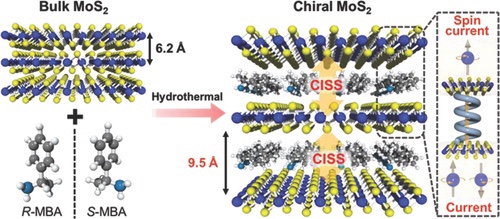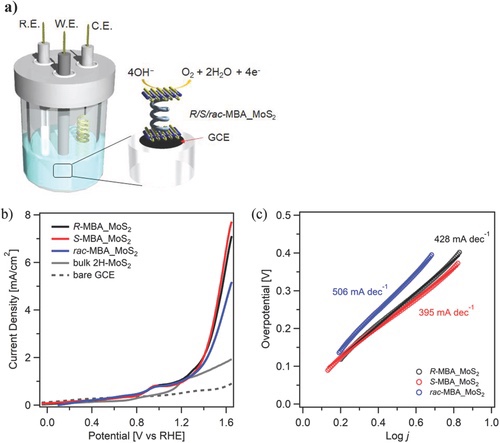

Kyoto Univ:水電解で水素発生効率を向上:
Améliorer l’efficacité de la génération d’hydrogène:
Effizienz der Wasserstofferzeugung:
Improve hydrogen generation efficiency:
通過水電解提高制氫效率
ー電流中の電子スピンの向き制御ー
京都大学
科学技術振興機構(JST)5月2日、
「水電気分解による水素の発生効率を向上させる技術」を京大が開発した。
電流中の電子スピンの性質:
「二硫化モリブデン」(MoS2)の層間にキラル分子を挿入した。
「キラルMoS2」が「電流中の電子スピンの向きを同じ方向に揃える性質」を
持つことを見出した。
酸素発生効率が1.5倍向上:
水電気分解(水電解)における電極材料として、これを用いた。
- 「スピンの向きが揃った電流効果」により、
- 「水電解効率が悪かった酸素発生効率」が、
- 「スピンが揃ってないラセミMoS2の1.5倍」に向上。
過酸化水素の生成を抑制:
さらに、「過酸化水素の生成を70%以上抑制すること」を見出した。
主生成物のスピン状態:
酸素発生反応の主生成物である
- 酸素は、スピンが平行の三重項、
- 過酸化水素は、スピンが反平行の一重項、
2つのスピン状態を持っている。
「電流中のスピンの向きを平行に揃え、水電解すること」ができれば、
「三重項状態である酸素を、選択的に発生させられること」が考えられる。
研究チーム:
今回、
「右手と左手のように、鏡に映した構造がもとの構造と重ならない現象」に注目。
キラル分子が持つ「キラリティ誘起スピン選択性という現象」を利用した。
水電解の正極に塗布
この化合物を、水電解における正極(酸素発生反応が起こる電極)上に塗布した。
酸素発生反応効率:
スピンを制御していない場合(キラルではない構造を持ったラセミMoS2の場合)と比べて、約1.5倍に向上することも確認された。
TECH+
https://news.mynavi.jp/techplus/article/20220506-2339286/
Université de Kyoto : Améliorer l’efficacité de la génération d’hydrogène par électrolyse de l’eau :
-Contrôle de la direction des spins des électrons dans un courant électrique-
Université de Kyoto
Agence japonaise pour la science et la technologie (JST)Le 2 mai,
L’Université de Kyoto a développé une “Technologie pour améliorer l’efficacité de la génération d’hydrogène par électrolyse de l’eau”.
Propriétés du spin électronique dans le courant :
Des molécules chirales ont été insérées entre les couches de “disulfure de molybdène” (MoS2).
“Chiral MoS2” a “la propriété d’aligner les directions des spins électroniques dans un courant électrique dans la même direction”
Trouvé à avoir.
Efficacité de dégagement d’oxygène améliorée de 1,5 fois :
Cela a été utilisé comme matériau d’électrode dans l’électrolyse de l’eau (électrolyse de l’eau).
En raison de “l’effet de courant avec des directions de rotation alignées”
“Efficacité d’évolution de l’oxygène, qui était pauvre en efficacité d’électrolyse de l’eau”
Amélioré à “1,5 fois celui de Racemic MoS2 sans spin”.Suppression de la production de peroxyde d’hydrogène :
De plus, ils ont découvert que “la production de peroxyde d’hydrogène est supprimée de 70% ou plus”.
État d’essorage du produit principal :
C’est le produit principal de la réaction de dégagement d’oxygène.
L’oxygène est un triplet à spins parallèles,
Le peroxyde d’hydrogène est un singulet dont les spins sont antiparallèles,
A deux états de spin.S’il est possible “d’aligner les directions des spins dans un courant électrique en parallèle et d’électrolyser l’eau”,
Il est concevable que “l’oxygène à l’état triplet puisse être généré de manière sélective”.
Équipe de recherche:
cette fois,
Faites attention à “un phénomène dans lequel la structure réfléchie dans le miroir ne chevauche pas la structure d’origine, comme les mains droite et gauche”.
Nous avons utilisé le “phénomène de sélectivité en spin induite par la chiralité” des molécules chirales.
Appliqué à l’électrode positive de l’électrolyse de l’eau
Ce composé a été appliqué sur une électrode positive (une électrode dans laquelle se produit une réaction de dégagement d’oxygène) dans l’électrolyse de l’eau.
Efficacité de la réaction de dégagement d’oxygène :
Il a également été confirmé que l’amélioration était d’environ 1,5 fois par rapport au cas où le spin n’était pas contrôlé (dans le cas du MoS2 racémique ayant une structure non chirale).
TECH +
Universität Kyoto: Effizienz der Wasserstofferzeugung durch Wasserelektrolyse verbessern:
-Steuerung der Richtung von Elektronenspins in einem elektrischen Strom-
Universität Kyoto
Japanische Agentur für Wissenschaft und Technologie (JST)2. Mai,
Die Universität Kyoto hat eine „Technologie zur Verbesserung der Effizienz der Wasserstofferzeugung durch Wasserelektrolyse“ entwickelt.
Eigenschaften des Elektronenspins im Strom:
Zwischen die Schichten aus „Molybdändisulfid“ (MoS2) wurden chirale Moleküle eingefügt.
„Chirales MoS2“ hat „die Eigenschaft, die Richtungen von Elektronenspins in einem elektrischen Strom in die gleiche Richtung auszurichten“
Gefunden zu haben.
Effizienz der Sauerstoffentwicklung um das 1,5-fache verbessert:
Dieses wurde als Elektrodenmaterial bei der Wasserelektrolyse (Wasserelektrolyse) verwendet.
Aufgrund der “Stromwirkung bei ausgerichteten Drallrichtungen”
“Effizienz der Sauerstoffentwicklung, die bei der Wasserelektrolyse-Effizienz schlecht war”
Verbessert auf “das 1,5-fache von Racemic MoS2 ohne Spin”.
Unterdrückung der Produktion von Wasserstoffperoxid:Darüber hinaus fanden sie heraus, dass “die Produktion von Wasserstoffperoxid um 70 % oder mehr unterdrückt wird”.
Spinzustand des Hauptprodukts:
Es ist das Hauptprodukt der Sauerstoffentwicklungsreaktion.
Sauerstoff ist ein Triplett mit parallelen Spins,
Wasserstoffperoxid ist ein Singulett, dessen Spins antiparallel sind,
Hat zwei Spin-Zustände.Wenn es möglich ist, “die Richtungen der Spins in einem elektrischen Strom parallel auszurichten und Wasser zu elektrolysieren”,
Denkbar sei, dass „Sauerstoff im Triplett-Zustand selektiv erzeugt werden kann“.
Forschungsgruppe:
diesmal,
Achten Sie auf “ein Phänomen, bei dem die im Spiegel reflektierte Struktur nicht mit der ursprünglichen Struktur überlappt, wie z. B. die rechte und die linke Hand”.
Wir nutzten das “chiralitätsinduzierte Spinselektivitätsphänomen” chiraler Moleküle.
Angewandt auf die positive Elektrode der Wasserelektrolyse
Diese Verbindung wurde bei der Wasserelektrolyse auf eine positive Elektrode (eine Elektrode, in der eine Sauerstoffentwicklungsreaktion auftritt) aufgetragen.
Effizienz der Sauerstoffentwicklungsreaktion:
Es wurde auch bestätigt, dass die Verbesserung etwa das 1,5-fache im Vergleich zu dem Fall war, in dem der Spin nicht kontrolliert wurde (im Fall von racemischem MoS 2 mit einer nicht-chiralen Struktur).
TECH+
Hybrid Chiral MoS2 Layers for Spin‐Polarized Charge Transport and Spin‐Dependent Electrocatalytic Applications
Abstract
The chiral-induced spin selectivity effect
enables the application of chiral organic materials for spintronics and spin-dependent electrochemical applications.
It is demonstrated on various chiral monolayers, in which their conversion efficiency is limited.
On the other hand,
relatively high spin polarization (SP)is observed on bulk chiral materials; however, their poor electronic conductivities limit their application.
Here,
the design of chiral MoS2 with a high SP and high conductivity is reported.Chirality is introduced to the MoS2 layers through the intercalation of methylbenzylamine molecules.
This design approach
activates multiple tunneling channels in the chiral layers, which results in an SP as high as 75%.Furthermore,
the spin selectivity suppresses the production of H2O2 by-product and promotes the formation of ground state O2 molecules during the oxygen evolution reaction.These potentially improve the catalytic activity of chiral MoS2.
The synergistic effect is demonstrated
as an interplay of the high SP and the high catalytic activity of the MoS2 layer on the performance of the chiral MoS2 for spin-dependent electrocatalysis.
This novel approach
employed here paves way for the development of other novel chiral systems for spintronics and spin-dependent electrochemical applications.– Advanced Science – Wiley Online Library